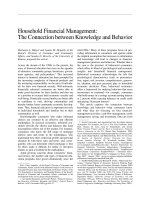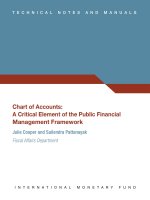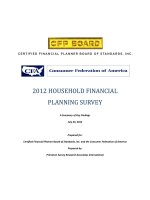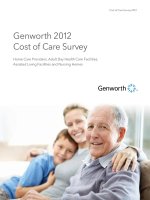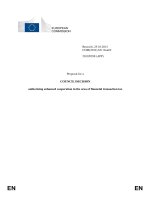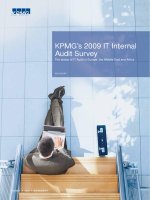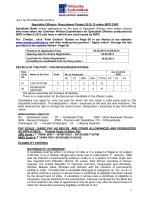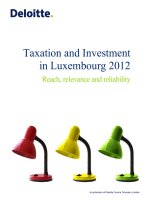2012 HOUSEHOLD FINANCIAL PLANNING SURVEY potx
Bạn đang xem bản rút gọn của tài liệu. Xem và tải ngay bản đầy đủ của tài liệu tại đây (670.52 KB, 60 trang )
2012HOUSEHOLDFINANCIAL
PLANNINGSURVEY
ASummaryofKeyFindings
July23,2012
Preparedfor:
CertifiedFinancialPlannerBoardofStandards,Inc.andtheConsumerFederationofAmerica
Preparedby:
PrincetonSurveyResearchAssociatesInternational
2
Contents
EXECUTIVESUMMARY 3
KeyFindings 3
AMuchTougherEconomicLandscapeforAmericanFamilies 3
MostPeopleFindManagingFinancesDaunting 4
FewerHavingSavingsforEmergenciesandChild’sCollege 5
MajorityHaveaPlanforSpendingGoal ,butFewhaveaFinancial Plan
5
PlannersMoreConfidentAboutHandlingtheirFinances,FeelBetterabouttheirProgress 6
PlanningBenefitsAllIncomeLevels,notjusttheWealthy 7
AbouttheSurvey 7
SECTION1:CURRENTECONOMICLANDSCAPE 8
SECTION2:SAVINGANDPLANNINGTOMEETFINANCIALGOALS 9
Saving
andPlanningforEmergencies 13
SavingandPlanningforRetirement 14
Pre‐retirement 14
DuringRetirement 16
SavingtoSendaChildtoCollege 16
SavingandPlanningforOtherFinancialGoals 16
SECTION3:CREDITCARDDEBT 18
SECTION4:THEIMPORTANCEOF
FINANCIALPLANNING 20
EmergencyandRetirementPlanning 20
ComprehensiveFinancialPlanning 22
APPENDIX 26
SAVERSANALYSIS 26
METHODOLOGY 30
DesignandDataCollectionProcedures 30
WeightingandAnalysis 32
TOPLINE 38
3
EXECUTIVESUMMARY
KeyFindings
StillfeelingtheeffectsoftheGreatRecession,manyAmericanfamiliestodaystrugglejusttomakeends
meet.TheCFPBoard/ConsumerFederationofAmericaHouseholdFinancialPlanningsurveyfinds
peopletodayfacingtoughe rchoicesabouthowtoallocatemorelimitedfinancialresources.Saving
enoughmoneyforfuturegoalslikeretirement
andkids’college–whilealsomaintainingana dequate
emergencyfundandstayingoutofseriousdebt–hasalwaysbeenachallenge.Thiswastrueevenin
themorefavorableeconomicclimateof1997,whenPrincetonSurveyResearchAssociatesInternational
firstsurveyedhouseholddecision‐makersaboutthesetopics.In2012,
withhighunemployment,
stagnantincomesandreducednetworth,thosechallengesareevengreater.
Whiletheeconomicclimatehaschanged,financialplanningremainsacriticalfactorinseparatingthose
whoareontracktomeettheirfinancialgoals fromthosewhoarefallingbehind.Thenewsurveyfinds
peoplewho
planfeelmoreconfidentabouttheirfinancialdecision‐making,man agetosavemore
money,andfeelbetterabouttheirprogresstodateinsavingforfinancialgoals.Plannersscorehigher
infinancialpreparednessthannon‐plannersacrossincomegroups.Thebenefitsarenotlimitedtothose
whoarebetteroff.
Too
fewAmericanfamiliesaretakingadvantageofthisvaluabletooltohelpprotecttheirfamiliesfrom
thevagariesofanuncertaineconomicenvironment. ThepercentageofAmericanfamilieswhohave
madeacomprehensivefinancialplan–eitherontheirownorwithprofessionalhelp–hasnotchanged
significantlyfrom
15yearsago.Overall,onlyaboutathird(31%)ofdecision‐makerstodayreporthaving
everputtogethersuchaplan.Andjust35percentofdecision‐makersreporthavingaplaninplaceto
saveforemergencies,downfrom39percentin1997.
AMuchTougherEconomicLandscapeforAmerican
Families
RecentreportsfromtheFederalReserveshowthedevastatingeffectsoffinancialcrisisonthemiddle
class.Themedianfamily,richerthanhalfofallAmericanfamiliesandpoorerthantheotherhalf,hada
networthof$77,300in2010comparedwith$126,400in2007accordingtothe
Fed.Thismeansthe
averagefamilyhasnomorewealthtodaythanitdidintheearly1990s,wipingoutnearlytwodecades
ofeconomicgains.
1
Ournewsurveydocumentstheeconomicpainpeopl earefeeling.In2012,
householdswherepeoplelivefrompaychecktopaycheckoutnumberthosewherepeoplefeel
1
“FamilyNetWorthDropstoLevelofEarly90’s,FedSays,”byBinyaminApplebaum,TheNewYorkTimes,June11,
2012.
4
financiallycomfortable(38%vs.30%).Fifteenyearsago,wheneconomicconditionsweremuchmore
positive,thesenumberswerereversed–fewerpeopledescribedthemselvesasfinanciallystruggling
thansaidtheywerelivingthegoodlife(31%vs.38%).FormostAmericans,theirhomehasbeentheir
biggestfinancialasset,butthe
crashofhousingpriceshasbeenthesinglebiggestfactorthat has
reducedpeople’swealth.Today,one‐quarter(23%)ofthosewithamortgagesayitisunderwater,i.e.,
themoneyrequiredtopayitoffisgreaterthanwhatthepropertycouldsell forontheopenmarket.
Looking
ahead,20percentofnon‐retiredhomeownersthinktheywillstillbemakingmortgage
paymentswhentheyretire,upfrom14percentin1997.
Speakingofretirement,people’sexpectationsforhowearlytheywillbeabletoretirehavebeenscaled
backconsiderably.Fiftee nyearsago,half(50%)ofnon
‐retireestoldusthattheyexpectedtoretire
beforetheyturned65.Now,onlyathird(34%)believestheywillbeabletoretirethisearly.Morethan
aquarter(27%)thinktheywillnotbeabletoretirebeforeage70,ifever.Thiscompareswith15
percentin
1997.Infact,13percentofthosenotyetretiredtodayvolunteer thattheywon’teverbe
abletostopworking,comparedwith4percentwhowerethispessimisticabouttheirretirement
prospects15yearsago.
MostPeopleFindManagingFinancesDaunting
Astheeconomicenvironmenthaschangedfortheworse,
people’scomfortlevelwithfinancialmatters
hasnotimproved.Advancesintechnologyhavemadeaccessingandanalyzing financialinformation
mucheasier,butlackofunderstandingaboutsavingsandinvestmentsoptionsandhowtobestmanage
householdfinancesremainsaseriousobstacletoAmericans’financialpreparedness.
55%say“it’shard
formetoknowwhototrustforfinancialadvice.”
52%say“tomeinvestingseemscomplicated.”
55%say“I’mworriedaboutlosingmymoneyifIinvestit,”asignificantincreasefrom1997
(45%)reflectinggrowinguncertaintyinresponsetothestockmarketturbulenceofrecentyears.
In
additiontothesebarrierstosoundmoneymanagement,halfofhouseholddecision‐makersbelieve
they“justdon’tearnenoughmoneytosaveregularly.”Majoritiesofthoseintheunder $25,000(61%)
and$25,000‐$49,999(64%)incomebracketsfeeldiscouragedfromsavingforthisreason.Eveninthe
$50,000‐$99,999category,
half(50%)feeltheirincomelevelisabarriertosavingregularly.Andone‐
quarter(26%)inthe$100,000ormorecategoryareinclinedtobelievethattheirincomeisinsufficient
toallowthemtosaveonaregularbasis.
5
FewerHavingSavingsforEmergenciesandChild’sCollege
Feelingmorefinancialpres suretodaythanin1997,Americanfamiliestodayarelesslikelytobesaving
fortheirfinancialgoalsandtakingstepstokeeptheirfamilyfinanciallyprepared.Likeitspredecessor,
thenewsurveyaskeddecision‐makersabouttheirsavingand
investmentsinsixspecificcategories.
Fewerpeopletodayreporthavingsavedtowardoneormoreoftheirgoalsthandidsofifteenyearsago
(80%vs.84%).Withlessmoneytogoaround,fewerAmericanshavestartedsavinginsomeimportant
areas:
Fewerpeoplereportsavingforemergencies,leaving
theirfamilymorevulnerabletothe
upheavalcausedbyajoblossormajorunexpectedexpenses(63%vs.68%).
Fewerofthoseinfamilieswithacollege‐boundchildhavestartedtosaveforcollegeeducation
(48%vs.56%),eventhoughcostsofacollegeeducationarerisingat
arapidpace.
Peopletodaymaybemoreinclinedtoputtheireconomicsecurityatriskto“keepupwiththeJoneses.”
Theonlyareawherefamiliesaremorepronetosaveistowardamajorpurchase,likeanewcar,
vacation,orhomeimprovementproject.
TheproportionofAmericansnot
yetretiredwhohaveatleastsomesavingsforretirementhasheld
steady.However,afterthehitmanyfamiliestookafterthefinancialmeltdownfouryearsago,more
non‐retireesfeeltheyarebehindwheretheyshouldbeinsavingfortheirretirement(51%vs.38%in
1997).
MajorityHave
aPlanforSpendingGoal,butfewhaveaFinancialPlan
MostAmericanfamiliesdosomekindoffinancialplanningtohelpaccomplishtheirsavingsgoals,but
relativelyfewhaveeverputtogetherthekindofdetailedfinancialplanthatmoneymanagement
expertsrecommend.Whenaskediftheywereimplementinga
plantomeetsavingsgoalsinsixspecific
areas,abouttwo‐thirds(65%)ofdecision‐makerssaytheyfollowaplanforatleastoneoftheirsavings
goals.Thiscompareswithonly31percentwhosaytheyhaveeverprepare dacomprehensivefinancial
plan–orusedaprofessional
toprepareone–thatincludesthingslikesavingsandinvestments,
retirementplanning,andinsuranceneeds.
Planningismostoftenreportedforsavingforone’sretirement.Asmanyashalf(49%)ofnon‐retirees
saytheyhavebegunsavingforretirementandfollowaplanorscheduleforhowoften,how
much,and
wheretheyaresavingorinvestingforthispurpose.Sincethe1990s,trendsinworkplaceretirement
benefitshaveshiftedawayfrompensionsandothervehicleswheretheemployermakesalldecisions
toward401‐kandsimilarretirementplanswhereemployeesmakedirectcontributionsanddecisions
themselves.Thesurvey
foundasignificantincreaseinhowmanyofthoseenrolledin401‐korsimilar
6
plansmakeannualcontributions(77%vs.66%).Despitethispositivetrend,thenumberofnon‐retirees
whosaytheyhaveaplaninplacetoinvestforretirementisessentiallyunchanged(49%vs.51%in
1997).
Asmightbeexpected,thosewithhigherincomesaremorelikelytoplan.Overhalf
(55%)ofthosewith
householdincomesof$100,000ormorehaveacomprehensiveplan,comparedwithroughlyathird
(35%)ofinthe$50,000‐$99,999bracket,andaquarter(25%)ofthoseinthe$25,000‐$49,999bracket.
Suchplansareararityamongthosewithincomeslowerthan$25,000(10%).
PlannersMoreConfidentAboutHandlingtheirFinances,FeelBetterabouttheirProgress
Familieswithgreaterfinancialresourcesaremuchmorelikelytobesavingfortheircurrentandfuture
financialgoals.Thenewsurveyshowsthatasfamilyincomelevelrises,sodoesthepercentageof
decision‐makerswhosaythey
haveatleastsomesavingsfortheirvariousgoals.Forexample,among
thosewithincomesunder$25,000onlyaboutthreein10(31%)haveanythingsavedforemergencies,
comparedwithninein10ofthosewithincomesof$100,000ormore.Similarrelationshipsbetween
incomelevelsandsavingsrateswere
observedin1997.Butwhileincomelevelmatters,financial
planningisanotherkeyfactordistinguishingthosewhoarebetterpreparedfinanciallyfromthosewho
arelesswellprepared.Thosewithacomprehensivefinancialplanshowthems elvestohavethe
followingadvantagesovernon‐planners.
Byamarginof52percentto
30percent,plannersaremorelikelytofeel“veryconfident”about
managingmoney,savingsandinvestments.Inallfourincomecategoriesusedforanalysis,plannersare
foundtobesignificantlymoreconfide ntthanthosewithoutacomprehensivefinancialplan.Planners
arealsomorelikelytofeeltheyareonpace
inmeetingalltheirspecificfinancialgoals,suchassavingfor
retirement,emergencies,andcollege(50%vs.32%).Inallexceptthelowestincomecategories–where
fewhaveacomprehensiveplan–plannersaresignificantlymorelikelytofeelgoodabouttheirprogress
towardmeetingkeygoals.
Plannersarealso
morelikelythannon‐plannerstodescribethemselvesas“livingcomfortab ly” (48%vs.
22%).Thebenefitsherearemostevidentinthetwohighestincomecategories.Thosewitha
householdincomeof$100,000ormoreandacomprehensiveplanaremostlikelytofeeltheyareliving
thegoodlife.
Butitisnoteworthythatasmanyplannersinthe$50,000‐$99,999incomebracketsay
theylivecomfortablyasthoseearning$100,000ormorebutdonothaveacomprehensivefinancial plan
(50%vs.46%).
7
PlanningBenefitsallIncomeLevels,notjusttheWealthy
Thebenefitsofacomprehensivefinancialplanarefurtherdemonstratedbythesmartsavingandmoney
managementpracticesassociatedwithit.Forthoseathigherincomelevels,plannersputmoreoftheir
incomeintosavingsthannon‐plannersandreporthavingbuilt
greaterwealth.Forexample,planners
withincomesof$50,000‐$99,999aremorelikelythannon‐planne rstosaytheysave10percentoftheir
incomeormore(57%vs.39%)andtohaveaccumulatedatleast$100,000ininvestmentssofar(37%vs.
19%).Similardifferencesarefoundbetweenplanners
andnon‐plannersinthe$100,000ormore
incomebracket.
Financialplanningisoftenseenasatoolforthemoreaffluent,butthesurveypr ovidesstrongevidence
thatthosewithmodestincomesalsobenefit.Familieswithfewerfinancial resourcesaremost
vulnerabletocreditcarddebtspiralingoutofcontrol.
Havingafinancialplanisassociatedwithhandling
creditcardbillsinawaythatminimizesriskofcreditcarddebtproblems.Amongthoseinthe$25,000‐
$49,999incomecategory,46percentofthosewithaplansaytheyusuallypaytheircreditcardbillinfull
eachmonth,compared
with26percentofnon‐planners.Themarginis41percentto16percent
betweenplannersandnon‐plannersintheunder$25,000category.
AbouttheSurvey
TheseareamongthefindingsofasurveyjointlysponsoredbyCertifiedFinancialPlannerBoardof
Standards,Inc.andtheConsumerFederationofAmerica.Thesurveyincludedtelephoneinterviews
witharepresentativesampleof1,508financialdecisionmakersnationwide.Thesurvey,conductedby
PrincetonSurveyResearchAssociatesInternational,askedquestionsabout
thehousehold’sfinancial
goalsandliabilities,thehousehold’sstrategyforsavingandinvesting,aswellasspecificsofhowmuch
wasbeingsavedandinvested.Sixfinancialgoalswereinvestigatedindepth:savingforemergencies,for
retirement,foramajorpurchase,forachild’scollegeeducation,foradownpayment
onahouse,andto
helpaparentorolderrelativewithlivingormedicalexpenses.InterviewswereconductedfromMay7‐
20,2012.
Themarginofsamplingerrorforresultsbasedontotalsampleatthe95percentlevelofconfidenceis
plusorminusthreepercentagepoints.Questionwording
andthepracticaldifficultiesinconducting
surveyscanalsointroduceerrorinsurveyestimates.Adescri ptionofthesurveymethodologyanda
questionnaireannotatedwiththesurveyresultsareincludedintheappendixthatfollowsthedetailed
findings.
8
SECTION1:CURRENTECONOMICLANDSCAPE
Theeconomiclandscapehaschangedsignificantlyinthe15yearssince thissurveywaslastconducted.
TheCFPBoard/ConsumerFederationofAmericaHouseholdFinancialPlanningsurveyfindsthatdecision
makerstodayarehavingatoughertimeintoday’seconomy.Thecurrentsurveymeasuredmanyofthe
sameattitudesandbehaviorsas
theinitialsurveydidin1997.Formanytheirpersonaleconomic
conditionsarenotaspositiveasin1997.Today,just30percentoffinancialdecisionmakers
2
saythey
livecomfortably,comparedwith38percentwhoreporteddoingsoin1997.Conversely,moredecision
makersreportthattheyhavejustenoughtomeettheirbasiclivingexpensesortheydon’thaveenough
tomeettheseexpenses(38%),comparedwithjust31percentwhoreportedsimilarconditionsin
1997.
FormanyAmericans,theideaofahomeasafinancialinvestmenthasfaded.Whiletheoverallrateof
homeownershiphasremainedthesame,fewerdecisionmakerswhodonotownahomereportthat
theyplantobuyone(61%in2012v.69%in1997 ).Amongthose
whoalreadyownahomefewersay
theyarelikelytohaveitpaidoffbythetimetheyretire.In1997,82percentreportedtheywouldhave
theirhomepaidforbythetimetheyretire,comparedto76percentinthecurrentsurvey.Forabout
one‐quarterof
decisionmakers,theirinvestmentinahomehaslostmoney.Twenty‐threepercentof
thosewithmortgagessaythattheyowemoreontheirmortgagethentheycouldsell thehousefor.
Decisionmakers’perceptionsoftheirretirementhavechangedaswell.Inthecurrentsurvey,one‐third
(34%)of
thosenotyetretiredsaytheywouldbeabletoretirebeforeage65.Thisisdownsignificantly
from50percentin1997whoreportedtheyexpectedtoretirebeforeage65(seeFigure1).
2
Financialdecisionmakerswereselectedbyasking“Whousuallymakesthefinancialdecisionsinyour
household?”Thosethatmakesolelyorsharethedecisionmakingwereeligibleforthesurvey.
50%
34%
0%
20%
40%
60%
80%
100%
1997 2012
Figure1:PlantoRetirebeforeage65
Basedonthosenotyetretire
1997
2012
9
SECTION2:SAVINGANDPLANNINGTOMEETFINANCIALGOALS
Whiletheconditionshavechangeddramatically,amajority ofdecisionmakersstillreporttheyhave
savingsorinvestmentsforatleastoneoftheirfinancialgoals.Eightin10Americans(80%)havesome
savingsforatleastoneofthefinancialgoalsaskedaboutinthe2012survey.Thisis
adecreasefromthe
84percentofdecisionmakerswhoreportedtheyhadsomesavingsforanyofthespecificfinancialgoals
inthe1997survey.
Althoughalargemajorityofdecisionmakersaresaving
fortheirfinancialgoals,manyfindfinancial
investmentsandstrategiesconfusing.One‐halfof
respondents
saythestatement‘investingseems
complicated’describesthemveryorsomewhatwell,
similartothe1997finding.Similarmajoritiesof
decisionmakersalsosay‘it’shardtoknowwhototrust
forfinancialadvice,’andthat‘I’mworriedaboutlosing
mymoneyifIinvestit’describesthemveryor
somewhat
well( seeTable1).Giventhevolatilestock
marketoverthepastdecade,itisnotsurprisingthata
largershareofrespondentsinthecurrentsurveysay
theyareworriedaboutlosingmoneyiftheyinvestit,
thandidsoin1997.
Inadditiontothecomplicatednature
ofinvestment
choices,foralargenumberofrespondentsthereare
alsobarrierstosaving,suchasbelievingthattheirearningsareinsufficienttosaveregularlyandthat
unexpectedexpensesmakeithardtosticktoabudget.
Lookingatthespecificsixgoalsaskedaboutinthesurvey,amajority
ofthosewitheachofthefollowing
goalsreporttheyhavesavingsforthem:emergencies,futureretirement, andamajorpurchase(see
Table2).Justaboutone‐halfreporttheyaresavingforachild’scollegeeducation,andfarfewer
decisionmakersreporttheyaresavingforadown
paymentforthepurchaseofahouseinthenext10
years,ortohelpparentsorotherolderrelativeswithlivingormedicalexpenses.
Table1:FeelingsaboutFinancialMatters
DescribesVeryorSomewhatWell…
It’shardformetoknowwhoto
trustforfinancialadvice
2012 55%
1997 54%
I’mworriedaboutlosingmy
moneyifIinvestit
2012 55%
1997 45%
Tome,investingseems
complicated
2012 52%
1997 55%
Iprefernottothinkaboutmoney
2012 43%
1997 42%
Unexpectedexpensesmakeit
hardformetosticktoabudget
2012 59%
1997 58%
Ijustdon’tearnenoughtosave
regularly
2012 51%
1997 54%
10
Table2:Saving&PlanningforSpecificFinancialGoals
Basedonthosewitheachspecifiedgoal
Total
Saving
forGoal
Saving&
HavePlan
forGoal
Savingfor
Goal,but
NoPlanfor
Goal
Total
Not
Saving
forGoal
N’s
Emergencies
2012 63% 35% 28% 36%
1508
1997 68% 39% 29% 31%
177
0
FutureRetirement
2012 61% 49% 12% 39%
984
1997 64% 51% 13% 35%
1451
CurrentRetirement
2012 62% n/a n/a 35%
524
1997 61% n/a n/a 35%
319
Majorpurchase
2012 60% 37% 22% 40%
643
1997 52% 32% 19% 46%
821
College
2012 48% 31% 17% 52%
409
1997 56% 36% 20% 43%
635
Downpaymentonhouse
2012 34% 17% 17% 66%
228
1997 34% 15% 19% 66%
365
Helpparentswith
medicalexpenses
2012 14% 7% 7% 85%
437
1997 17% 10% 7% 82%
503
Therehavebeensomechangessince1997inthesharesofrespondentsreportingtheyaresavingfor
theirvariousgoals.Fewerfinancialdeci sionmakersreporttheyaresavingforemergenciesthandidso
15yearsago.Likewise,fewerdecisionmakerswiththegoalofsendingachildtocollegehavesavings
forthisgoal.
Akeycomponentofsavingsuccessfullyishavingapl antosave.Ingeneral,decisionmakerswitha
specificgoalareplanningforthisgoalaswell.Forexample,37percentofdecisionmakersaresaving
andplanningforamajorpurchase,comparedwith22percentwho
aresavingbutdonothaveaplan.
Whenlookingatplanningforone’sspecificfinancialgoals,theonlystatisticallysignificantchangefrom
1997isinhavingaplanforemergencyexpenses,few errespondentsinthecurrentsurveyreportthat
theyhaveaplanforsaving.
Unsurprisingly,annualincomeisclosely
relatedtowhetherahouseholdhassavingstomeetitsfinancial
goals.Asannualincomeincreasessodoestheshareofrespondentswitheachgoalwhosaytheyare
11
savingforallgoalsaskedaboutinthesurvey(seeTable3).Forexample,whilejust15percentofnon‐
retiredhouseholdswithannualincomes lessthan$25 ,000aresavingforretirement,thisrisestoabout
halfofthoseinthenextincomebracket,toeightin10amongthose
withincomesbetween$50,000and
$99,999,andsavingforretirementisnearlyuniversalamongthosewithincomesof$100,000ormore.
Table3:SavingsforSpecificFinancialGoalsbyHouseholdIncome
Lessthan
$25,000
$25,000‐
$49,999
$50,000‐
$99,999
$100,000
ormore
PercentSavingfor…
Emergencies 31% 59% 78% 90%
FutureRetirement 15% 53% 79% 97%
CurrentRetirement 33% 70% 80% 81%
Majorpurchase 33% 52% 64% 81%
College 19% 41% 58% 70%
Downpaymentonhouse 15% 32% 52% 51%
Helpparentswithmedical
expenses
7% 14% 12% 22%
12
Althoughmostfinancialdecision
makersaresavingforatleastone
financialgoal,asizableproportionsay
thattheyfeelbehindontheirprogress
orthattheyshouldhavestarted
alreadysavingfortheirfinancialgoals.
Sixty‐threepercentofhousehold
financialdecisionmakerswhoare
savingsaytheyhaveat
leastonegoal
thattheyfeelbehindon,compared
with57percentin1997.
Againstthebackdropofafluctuating
stockmarket,alargershareofnon‐
retiredrespondentsreportthatthey
feelbehindonsavingforretirement
thandidsoin1997(seeTable4for
individualgoals).
Todayone‐halfof
non‐retiredrespondents,compared
with38percentin1997,saytheyfeel
behindorshouldhavealreadystarted
savingforretirement.
Thosewithaspecificplanforsavingforthatgoaltendtofeelbetterabouttheirprogresstowards
saving.
3
Alargershareofthosewithaplanforsavingforcollegeeducationsaytheyareaheadthan
thosewithoutaplan(seeFigure2).Asimilarpatternisobservedwithrespecttosavingforfuture
retirementandemergencyexpenses.
3
Notallsamplesizeswerelargeenoughtoanalyze,includingdownpaymentonahouseandparents’medical
expenses.
Table4:FeelingofProgresstowardsSaving
forSpecificFinancialGoals
Basedonthosewitheachspecifiedgoal
Feel
Behind/Should
HaveStarted
Ahead/About
Right/Okto
StartLater
N’s
Emergencies
2012 41% 54%
1508
1997 39% 57%
177
0
Future
Retirement
2012 51% 45%
984
1997 38% 60%
1451
Majorpurchase
2012 38% 58%
643
1997 36% 60%
821
College
2012 52% 42%
409
1997 45% 52%
635
Downpayment
onhouse
2012 48% 49%
228
1997 46% 51%
365
Helpparentswith
medicalexpenses
2012 41% 46%
437
1997 32% 58%
503
13
SavingandPlanningforEmergencies
Akeyelementinfinancialpreparednessishavingsavingsforthoseunexpectede xpenses and
emergencies,suchasthelossofajoboranunforeseenmedicalexpense.WhileamajorityofAmericans
reporttheyhavesavingsforemergencies(63%),fewerhavesavingsthandidso
in1997when68
percentreportedhavinganysavingsforemergencies.
Thosemostvulnerableareleastlikelytohavesavingsforemergencyexpenses.Thirty‐one
percentofthosewithincomelessthan$25,000,comparedwith75percentofthoseearning
more,reporttheyhavenosavingsforemergencies.
Those
inahouseholdwithjustoneemployedpersonarealsolesslikelythantwo‐worker
householdstohaveemergencysaving(62%v.74%).
Whileamajorityhavesavingsforemergencyexpenses,asignificantsharestillfeeltheyarebehindor
shouldhavealreadystartedsavingforemergencies(41%),similarto
the39percentwhoreportedsoin
1997.
One‐thirdofAmericans(35%)reporttheyhaveaspe cificplanforhowoften,howmuchandwhereto
saveandinvesttheirmoneyforemergencies.In1997,aslightlylargershare(39%)reportedthesame
planning.
Likewise,fewerAmericanssavingforemergencies
areputtingtheirmoneyinaseparatesavingsor
investmentaccount.Inthecurrentsurvey,aboutone‐half(48%)reporttheirsavingsareinaseparate
account,downfrom60percentin1997whoreportedkeepingtheiremergencysavingsseparatefrom
therestoftheirmoney.
20%
15%
17%
2%
3%
10%
0%
10%
20%
30%
40%
50%
College FutureRetirement Emergencies
Figure2:FeelAheadonSavingforGoal
Planforspecificgoal
NoPlan
14
Although,fewerrespondentsaresavingforemergenciesthanin1997,thosewhohavesomesavings
havesimilaramountssavedasthoseinthe1997survey.Aboutone‐halfofdecisionma kershaveno
savingsorhavelessthan3monthsofemergencylivingexpensessaved(seeFigure3).Similarresults
wereobservedin1997.
SavingandPlanningforRetirement
Inthecurrentsurvey,threeinfourdecisionmakers,workingandretired,havesomesavingsor
investmentsallocatedfortheirretirement(73%).Thisissimilartothe1997finding,when anequal
shareofalldecisionmakersreportedtheyhadsome
savingsforretirement.Theseretirementsavings
canbeeitherthroughanemployerprovidedplanorsettingmoneyasideforonone’sownfor
retirement,suchasinanIndividualRetirementAccount(IRA).
Pre‐retirement
Inthecurrentsurvey,sixin10respondentswho arenotyetretiredsaytheyha ve
atleastsomemoney
savedorinvestedfortheirretirement,while39percentreporttheyhavenosavingsforretirement.This
findingissimilarto1997(seeTable5).
15
Notsurprisinglytheyoungest(thoseage18to24)aretheleastlikelytobesavingfor
retirement.Thoseages35andolderaresignificantlymorelikelythanboththe18to24year
oldsandthe25to34yearoldstohaveanymoneysavedfor
retirement.
Aboutone‐halfofnon‐retiredrespondentsreporttheyhaveaspecificplanforhowandwheretosave
orinvesttheirmoneyforretirement,similartothe1 997findin g. Inthecurrentsurvey,alargershareof
non‐retiredrespondentsreporttheyhavecalculatedhowmuchmoneytheywill
needinretirement.In
2012,42percentofnon‐retiredrespondentssaytheyhavecalculatedhowmuchmoneythey willneed
inordertomaintaintheirstandardoflivingduringretirement,comparedwith34percentwhosaidthe
samein1997.
Thoseclosertoretirementagearemorelikely
tohavemadethiscalculation.Fiftypercentof
non‐retiredrespondentsagesof45andolderhavecalculatedhowmuchthey’llneedtosavefor
theirretirement,comparedwith39percentofthosenon‐retiredrespondentsbetweentheages
of25and44.
Whiletheoverallshareofthosesayingthey
havesavingsorinvestmentsforretirementhasremained
aboutthesame,asignificantlylargerproportionofthosenotyetretiredsaytheyarefeelingbehindor
shouldhavealreadystartedtheirsavingforretirementthandidsoin1997(51%v.38%).
Nearlysixin10oftheyoungest
respondents(thoseunderage25)thinktheyareinOKshapeor
canstartsavinginthefuture,farmorethananyotheragegroup.Amajorityofnon‐retired
respondentsages35to64(56%)saytheyfeelbehindorshouldhavealreadystartedsavingfor
retirement.
Decisionmakersstill
feelbehindonsavingforretirement,eventhoughlargemajoritieshaveaccessto
employer‐basedretirementsavingsplans.Overall,three‐quartersofthoseinworkinghouseholds(72%)
havesomeformofemployer‐basedsavingsofferedtothem,includinga401‐k,anemployeestock
ownershipplan,orsomeothertype
ofemployer‐base dsavings,pension,orprofitsharingplan.
Table5:SavingforRetirementbyAge
Basedonthosewhoarenotyetretired
Total 18‐24 25‐34 35‐44 45‐54 55andolder
Haveanymoney
savedforretirement
2012 61% 35% 55% 66% 64% 71%
1997 64% 30% 63% 72% 73% 75%
16
Specifically,alargershareofdecisionmakersinworkinghouseholdshaveaccesstoa401‐korother
retirementplanatworkwheretheycanmakedirectcontributionsthandidsoin1997(67%vs.55%).
Amongfinancialdecisionmakerswithaccesstoa401‐korotherretirementplanwhere
theycanmake
contributionsthemselves,77percentreporttheydosoeveryyear,asignificantincreasefrom1997
when66percentreportedcontributingeveryyear.
Fornon‐retireddecisionmakers,themainvehicleforsavingforretirementisthroughtheemployer,far
feweraresavingontheirown.Threein
10nonretiredrespondents(31%)reportsettingmoneyaside
forretirementinaccountsorinvestmentsontheirown,and22percentreportcontributingtoanIRAon
ayearlybasis.
Alargemajorityofthosewhoarenot retiredwithmoneysavedforretirementuseseparateaccounts
(77%),ratherthanusing
oneaccountforbothretirementsavingsandfundsintendedforotherpurposes
(20%).
DuringRetirement
Threeinfiveretiredrespondents(62%)havesomemoneysavedorinvestedtopayforexpensesduring
theirretirement.In1997,asimilarsharereportedhavingmoneysavedforretirement(61%).Roughly,
onehalfof
thosewhoareretiredandhaveretirementsavingshavecalculatedhowmuchtheycan
affordtowithdrawannuallyandstillhaveenoughsavingstolasttherestoftheirlifetime(53%).In
1997,astatisticallysimilarshareofretiredrespondentsreportedmakingthiscalculation(46%).
SavingtoSendaChildto
College
Thecostofacollegeeducationhasbeenrisingwellaheadofinflationoverthepastfewdecades,making
itagreatereconomicburdenforfamilies.Inthecurrentsurvey,fewerrespondentswiththegoalof
sendingachildtocollegereporttheyhaveanysavingsforthisgoal.
In2012,48percentreporttheyhad
anyamountofmoneysavedorinvested,comparedwith56percentin1997.One‐halfofdecision
makerswiththegoalofsendingachildtocollegesaytheyfeelbehindinsavingorfeeltheyshouldhave
alreadystarted,similartotheresult
in1997.
Thirty‐onepercentofrespondentswiththegoalofsavingforachild’scollegeeducationhaveaplanfor
saving,statisticallysimilartothe36percentwhoreportedthesamein1997.
SavingandPlanningforOtherFinancialGoals
Otherfinancialgoalswereaskedaboutinthesurvey,
includingsavingforamajorpurchaseinthenext
fewyears,adownpaymentonahome,andparents’orolderrelatives’livingormedicalexpenses.A
largershareofrespondentswiththegoalofmakingamajorpurchaseinthenextfewyears,suchasa
17
carorhomeimprovementproject,haveatleastsomemoneysavedforthisgoalthandidsoin1997
(60%v.52%).Aboutoneinthreerespondentshasaplantosaveformajorexpenses,similarto1997.
Whileamajoritywiththegoalofmakingamajorpurchasearesaving,
asizableproportionsaytheyfeel
theyarebehindinsavingorshouldhavealreadystartedsaving.Thirty‐eightpercentsaytheyfeel
behindinsavingforamajorpurchase,asimilarfindingto1997.Fourin10arekeepingthesesavingsin
aseparateaccount,whilethemajority(55%)
keepsthisearmarkedmoneymixedwithmoneyforother
purposes.
One‐thirdofthosewiththegoalofbuyingahouseinnext10yearshavesomesavingsforthedown
payment(34%).Thisfindingissimilarto1997.Abouthalfoftheserespondentshopingtobuyahome
havea
planforsavingwhiletherestdonot.
Potentialhomebuyersareequallydividedonwhethertheyfeelbehindorshouldhavealreadystarted
saving(48%)orwhethertheyareontrackwiththeirsavingsorbelieveitisokaytostartsavinginthe
future(49%).Similarly,theyare
dividedonkeepingthemoneyinaseparateaccount(46%)orina
multi‐purposeaccount(51%).
Aswasobservedinthe1997survey,fewrespondentsaresavingforaparent’sorolderrelative’s
medicalexpenses(14%in2012and17%in1997).Theshareofthosewithaplanfor
thisgoalis
unchangedaswellsince1997.
Givenrisingmedicalexpenses,itisnotsurprisingthatalargershareofrespondentswiththegoalof
helpingaparentwithmedicalexpensesreporttheyfeelbehindinsavingthan didsoin1997(41%v.
32%).Respondentswhoaresaving
forthisgoalareaslikelytokeepthemone yinaseparateaccount
(53%)asamixedaccount(44%), statisticallysimilarto1997.
18
SECTION3:CREDITCARDDEBT
Similartosavingforemergenciesandretirement,reducingdebtisamajorfinancialgoalforsignificant
proportionofdecisionmakers.One‐halfofhouseholdfinancialdecisionmakersinthesurveyreport
somesortofhouseholddebt–includingcreditcardsandcollegeloansforeithertheirowncollege
educationortheir
child’s.
Forty‐sevenpercentoffinancialdecisionmakersreporttheyhavesomecreditcarddebt.Fourteen
percentofdecisionmakersreporttheircreditcarddebtislessthan$1,000,17percentreportit’s
between$1,000and$4,999,while16percentreportits$5,000ormore(seeFigure5).Forty‐three
percentofrespondentsreportthattheyhavenocreditcarddebt.
Aboutonein10decisionmakerswithatleastonecreditcardreportstheypayjusttheminimum
balancewhentheygetacreditcardbill.Forty‐fivepercentreporttheyarepayingoffthefullamountof
their
bill,and42percentsaytheypaysomethinginbetween.
Twoin10financialdecisionmakers(22%)saytheyhavedebtcarriedoverfrommonthtomonththat
theyfeelneedstobepaidofforreduced.
Thosewithlargercreditcardbalancesaremorelikelytosaythey
havecreditcarddebtthat
needstobepaidoff.Sixty‐eightpercentofthoseowing$5,000ormoresaytheyhavedebtthat
needtobereduced,comp aredwith32percentofthosewithsmallerbalances.
Sixty‐twopercentofdecisionmakerswhofeeltheircreditcarddebtistoo
highhaveaspecificplanto
paydownthebalance,includingconsolidatingtheirdebtintoasingleloan.
Nodebt
43%
Lessthan$1,000
14%
$1,000‐$4,999
17%
$5,000ormore
16%
Nocards/No
answer
10%
Figure5:CreditCardDebt
19
Sixty‐fourpercentofthosewhowishtoreducetheircreditcarddebtandhavebalancesof
$1,000ormoresaytheyhaveaplanforreducingthisdebt,comparedwithjust47percentof
thosewithsmallercreditcardbalances.
One‐thirdofthosefinancialdecisionmakerswiththe
goalofreducingtheircreditcarddebtsaytheyfeel
behindinreducingtheirdebtorshouldhavealreadystartedtoreducetheirdebt.Aboutone‐halfsay
theyarewheretheyshouldbeorthatit’sokaytostartinthefuture(seeFigure6).
Thosewho
donothaveaplanforreducingtheircreditcarddebtaremorelikelythanthosewith
aplantosaytheyfeelbehindonthisgoal(45%v.29%).
Ahead
14%
Behind
36%
OK
47%
NoAnswer
3%
Figure6:ViewsonCreditCardDebt
Basedonthosewithgoalofreducingcreditcarddebt
20
SECTION4:THEIMPORTANCEOFFINANCIALPLANNING
EmergencyandRetirementPlanning
Therelationshipbetweenplanningandfinancialconfidenceisstrong.Earliersectionsofthisreport
showedarelationshipbetweenhavingaplanforaspecificfinancialgoalandone’sassessmentoftheir
progresstowardsachievingthatspecificgoal.Sixin10decisionmakers(63%)haveeitheraplan
for
theirretirementoremergencyexpenses.Thosewithaplanforeitherofthesefinancialgoalsaremore
likelytosaytheyfeelaheadontheirpr ogress towardssavingforthesespecificgoals(seeFigure7).
Thisfeelingoffinancialcomfortisbroaderthanbeingsatisfiedwithprogresstoward
thesespecific
financialgoals.Forexample,thosewithaplanforemergencyexpensesorretirementaremorelikelyto
saytheylivecomfortablythanthosewithoutaplanforeitherofthesecrucialitems.Theyarealsomore
likelytobeconfidentindealingwith financialmatters(seeTable6).
Likewise,thosewhoareplanningforeitherretirementoremergencylivingexpensesaremorelikelyto
befinanciallyprepared.Forexample,46 percentofthosewithplansineitheroftheseareasaresaving
10percentormoreoftheirincomeannually,comparedwithjust14percentofthosewho
donothavea
plan.Inaddition,alargershareofdecisionmakerswhohaveaplanforeitherretirementor
emergencieshave10monthsormorelivingexpensessaved,comparedtothosewithoutaplan.
Thoseearninglessthan$50,000seemtobenefitmostfromplanningforemergencyexpensesor
retirement.Thosewithplansattheselowerincomelevelsaremoreconfidentandincontroloftheir
financialsituation.Inaddition,largersharesofthosewithaplanaremorefinanciallypreparedforthe
futurethantheircounterparts.
12%
11%
3%
1%
0%
10%
20%
30%
40%
50%
Emergencies Retirement
Figure7:FeelAheadonSavingforSpecific
FinancialGoal
Basedonthosewitheitherretirementoremergencypla
Plan
NoPlan
21
Table6:FinancialPreparednessbyPresenceofeitherPlanfor
SavingforEmergencyExpensesorRetirement
andAnnualIncome
Total
Under
$25,000
$25,000‐
$49,999
$50,000‐
$99,999
Plan
No
Plan Plan
No
Plan Plan
No
Plan Plan
No
Plan
Percentwhosaythey…
Livecomfortably 37% 18% 15% 7% 21% 20% 40% 38%
Areconfidentinmanaging
money,savings,and
investments
89% 74% 85% 68% 88% 79% 88% 83%
Havehighfeelingof
controlovertheirfinances
41% 19% 28% 12% 28% 22% 38% 28%
Usuallypayoffwhole
amountoncreditcard
41% 22% 28% 14% 38% 20% 39% 38%
Have$100,000ormorein
savingsandinvestments
28% 5% 6% ‐‐ 14% 5% 29% 11%
Aresaving10%ormoreof
income
46% 14% 14% 9% 34% 13% 54% 24%
Have10monthsormore
ofemergencyexpenses
31% 13% 15% 5% 26% 12% 28% 20%
N’s 97
0
538 108 254 208 11
6
291 9
0
22
ComprehensiveFinancialPlanning
Asin1997,thecurrentsurveyclearlyshowsthebenefitsofhavingacomprehensivefinancialplanforall
decisionmakers,aplanthatincludessavingsandinvestments,planningforretirementandinsurance
needs
4
.Thecurrentsurveyfindingsdemonstratethatdecisionmakerswithacomprehensivefinancial
planaremorefinanciallyconfidentandcomfortablethanthosewithoutaplan.Inaddition,thecurrent
researchshowstheyhavemorepositivefinancialoutcomes.
Althoughcurrentandpastresultsshowtheimportanceoffinancialplanning,fewrespondentshave
ever
createdacomprehensivefinancialplan(seeFigure8).Inthecurrentsurvey,just31percentoffinancial
decisionmakers’reportthattheyhaveeverpreparedacomprehensivefinancialplanorhadone
preparedforthem.
Thirty‐sixpercentofdecisionmakersages45andolderhaveever
preparedacomprehensive
financialplan,comparedwith24percentofyoungerrespondents.
Thosewithhigherannualincomesaremorelikelytohaveafinancialplan.Just10percentof
thosewithincomeunder$25,000haveaplan,increasingto25percentamongthosewith
incomeof$25,000to$49,999,35
percentamongthosewithincomesof$50,000to$99,999,
and55percentofthosewithincomesof$100,000ormore.
Inthecurrentsurvey,20percentofthosewithoutafinancialplanreporttheyareveryorsomewhat
likelytohaveonepreparedinthenext12months.
4
Directcomparisonwith1997notavailable,seeAppendix‘Savers’.
Yes,HavePlan
31%
NoPlan
69%
Figure8:EverHadaComprehensiveFinancialPlan
Yes,HavePlan
NoPlan
23
Thosewithincomesof$50,000aremorelikelythanthosewithlowerannualincomestosay
theyarelikelytodevelopafinancialplaninthenext12months(27%v.17%).
Regardlessoftheirincomelevels,decisionmakerswithacomprehensivefinancialplanhavemore
positiveandconfidentfeelings
aboutvariousfinancialmatters.Thosewithafinancialplanaremore
likelytosaythattheydonotfeelbehindonanyoftheirspecificgoals,suchassavingforemergencies,
retirement,oramajorpurchase(seeTable7).One‐halfofthosewithafinancialplansaytheyfeel
very
confidenttheyaremakingthebestchoicestomanagetheirmoney,comparedwith30percentofthose
withoutafinancialplan.
Table7:AttitudesaboutFinancialMattersbyPresenceof
ComprehensiveFinancialPlanandAnnualIncome
Total
Under
$25,000
$25,000‐
$49,999
$50,000‐
$99,999
$100,000
ormore
Plan
No
Plan Plan
No
Plan Plan
No
Plan Plan
No
Plan Plan
No
Plan
Percentwhosay
they…
Livecomfortably 48% 22% 23% 8% 25% 19% 50% 34% 68% 46%
Areveryconfident
inmanagingmoney,
savings,and
investments
52% 30% 65% 30% 52% 33% 48% 22% 48% 34%
Don’tfeelbehindon
anyspecificgoal
50% 32% 44% 34% 44% 29% 45% 23% 50% 35%
Havehighcomfort
levelwithfinancial
Matters
37% 26% 18% 26% 30% 28% 32% 21% 50% 29%
Havehighfeelingof
controlovertheir
finances
49% 26% 20% 16% 24% 26% 47% 30% 71% 48%
N’s 537 962 52 307 95 228 148 231 16
0
117
Thecurrentsurveyfindingsalsoindicatethatdecisionmakerswithacomprehensivefinancialplanin
placearemorelikelytobefinanciallypreparedthanthosewithoutaplaninplace.Financial
preparednesswasmeasuredinseveralways,includingmonthsofemergencyexpenses,annualsavings
rate,andoverallsavings.Thosewith
financialplansarealsomorelikelytoavoidsomefinancialpitfalls,
suchasrevolvingcreditcarddebtordeclaringbankruptcy(seeTable8).
Lookingatthespecificindicatorsoffinancialpreparedness,42percentofthosewithafinancialplan
have10monthsormoreofemergencyexpensessavedcomparedto
16percentofthosewhodonot
24
haveaplan.One‐halfofthosewithafinancialplanaresavingatleast10percentoftheirincomeevery
yearcomparedtoone‐quarterofthosewithoutafinancialplan.Thosewithafinancialplanarealso
morelikelyhaveaccumulatedasignificantamount insavings.Thirty‐sixpercent
ofthosewithafinancial
planhave$100,000ormoreinsavings,comparedwithjust12percentofthosewithout aplan.
Ingeneral,thispatternofdifferenceisobservedacrossallincomelevels.Thosewithaplanaremore
likelytobefinanciallypreparedthanthosewithoutaplan.
5
Acrossallincomecategoriesthosewitha
financialplanaremorelikelytohave10monthsormoresavedinemergencyexpenses.Likewise,this
patternisobservedwhenlookingattotalsavings.Evenforthosewithannualincomesbetween$25,000
and$49,999,planningispowerful.Twentypercentofthosein
thisincomebrackethaveaccumulated
$100,000ormorecomparedwithjustsevenpercentofthosewithoutaplan.
Therealsoindicationsthatthosewhohaveafinancialplanaremorelikelytoavoidsomefinancial
dangers,suchascreditcarddebtandbankruptcy.One‐halfofthosewithafinancialplan
saythey
usuallypayoffthefullamountwhentheygetacreditcardbill,comparedtoroughlyone‐quarterof
thosewithoutafinancialplan.Therearesignificantdifferencesacrossmostincomegroupsonthis
measure,theexceptionbeingthoseearning$50,000to$99,999annually.
5
Significantdifferencesdonotappearacrossallincome categoriesoneverymeasure.
25
Table8:FinancialPreparednessbyPresenceofComprehensiveFinancialPlan
andAnnualIncome
Total
Under
$25,000
$25,000‐
$49,999
$50,000‐
$99,999
$100,000
ormore
Plan
No
Plan Plan
No
Plan Plan
No
Plan Plan
No
Plan Plan
No
Plan
Percentwhosay
they…
Have10monthsor
moreofemergency
expenses
42% 16% 30% 5% 33% 17% 40% 20% 49% 36%
Havesavingsfor
emergencies
83% 54% 62% 27% 66% 57% 87% 73% 92% 87%
Havesavingsfor
retirement
92% 65% 70% 31% 81% 77% 94% 88% 100% 95%
Aresaving10%or
moreofincome
50% 27% 21% 10% 22% 27% 57% 39% 73% 60%
Have$100,000or
moreinsavingsand
investments
36% 12% 13% *less
than
1%
20% 7% 37% 19% 69% 47%
Usuallypayoffwhole
amountoncreditcard
50% 27% 41% 16% 46% 26% 45% 36% 55% 41%
Haveneverdeclared
bankruptcy
92% 87% 94% 89% 86% 83% 90% 86% 93% 85%
N’s 537 962 52 307 95 228 148 231 16
0
117
